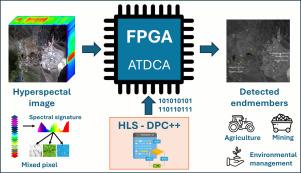High-level synthesis acceleration for an FPGA implementation of an optimized automatic target detection and classification algorithm for hyperspectral image analysis with Intel oneAPI
IF 3.7
3区 计算机科学
Q2 COMPUTER SCIENCE, INTERDISCIPLINARY APPLICATIONS
引用次数: 0
Abstract
For many years, hyperspectral images have been one of the most well-established technologies in remote sensing. The main difficulty in hyperspectral image analysis lies in the spectral mixing of materials within a single pixel, which hinders the identification of pure components or endmembers. This task is essential for various Earth observation applications, such as agriculture, mining, and environmental management. From the whole process, the endmember identification or target detection is usually one of the most time-consuming stages, so high-performance computing (HPC) platforms such as multicore processors, graphics processing units (GPUs) or field-programmable gate arrays (FPGAs) are necessary and essential for its exploitation in time-critical scenarios. In this article, we present a high-level synthesis (HLS) acceleration for an FPGA implementation of the automatic target detection and classification algorithm (ATDCA) using the Gram–Schmidt (GS) method for hyperspectral images with the Intel oneAPI Toolkit and DPC++ instead of traditional hardware description languages (HDL). Optimization strategies were applied in terms of parallelism and efficiency in the use of hardware resources on a Stratix 10 SX 2800 FPGA, resulting in a significant performance improvement. Experimental results showed that the optimized implementation through HLS achieved a significant reduction in processing times, demonstrating that the use of optimization techniques for FPGA platforms, combined with the DPC++ environment, provides an effective and flexible solution for spectral unmixing of hyperspectral images.

基于Intel oneAPI的高光谱图像分析优化自动目标检测和分类算法的FPGA实现高级综合加速
多年来,高光谱图像一直是遥感领域最成熟的技术之一。高光谱图像分析的主要困难在于单个像元内材料的光谱混合,这阻碍了纯组分或端元的识别。这项任务对于农业、采矿和环境管理等各种地球观测应用至关重要。从整个过程来看,端元识别或目标检测通常是最耗时的阶段之一,因此高性能计算(HPC)平台,如多核处理器、图形处理单元(gpu)或现场可编程门阵列(fpga)对于在时间关键场景中利用它是必要的和必不可少的。在本文中,我们提出了一种高级合成(HLS)加速,用于FPGA实现自动目标检测和分类算法(ATDCA),使用Intel oneAPI工具包和dpc++代替传统的硬件描述语言(HDL),使用高光谱图像的Gram-Schmidt (GS)方法。在Stratix 10 SX 2800 FPGA上应用了并行性和硬件资源使用效率方面的优化策略,从而显著提高了性能。实验结果表明,HLS优化实现显著减少了处理时间,表明基于FPGA平台的优化技术与dpc++环境相结合,为高光谱图像的光谱解混提供了一种有效、灵活的解决方案。
本文章由计算机程序翻译,如有差异,请以英文原文为准。
求助全文
约1分钟内获得全文
求助全文
来源期刊

Journal of Computational Science
COMPUTER SCIENCE, INTERDISCIPLINARY APPLICATIONS-COMPUTER SCIENCE, THEORY & METHODS
CiteScore
5.50
自引率
3.00%
发文量
227
审稿时长
41 days
期刊介绍:
Computational Science is a rapidly growing multi- and interdisciplinary field that uses advanced computing and data analysis to understand and solve complex problems. It has reached a level of predictive capability that now firmly complements the traditional pillars of experimentation and theory.
The recent advances in experimental techniques such as detectors, on-line sensor networks and high-resolution imaging techniques, have opened up new windows into physical and biological processes at many levels of detail. The resulting data explosion allows for detailed data driven modeling and simulation.
This new discipline in science combines computational thinking, modern computational methods, devices and collateral technologies to address problems far beyond the scope of traditional numerical methods.
Computational science typically unifies three distinct elements:
• Modeling, Algorithms and Simulations (e.g. numerical and non-numerical, discrete and continuous);
• Software developed to solve science (e.g., biological, physical, and social), engineering, medicine, and humanities problems;
• Computer and information science that develops and optimizes the advanced system hardware, software, networking, and data management components (e.g. problem solving environments).
 求助内容:
求助内容: 应助结果提醒方式:
应助结果提醒方式:


